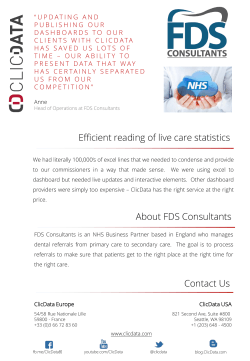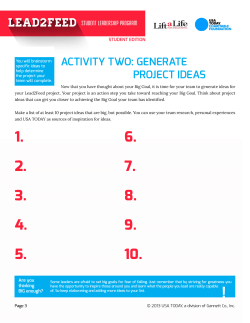
Murphy Matrix - Kilbride Consulting, Inc.
How do I use it? Murphy Matrix (Prevention & Recovery Planning) Whatever can go wrong, will. – Murphy‘s Law. What is it? A method that allows you to: Identify possible problems that may occur; Name the goal, plan or process for which you will complete the matrix. In every case, you will be completing the matrix in order "To assure successful" … Examples include: Possibilities GOAL: To assure successful… …completion of the XYZ project. Prioritize these based upon expected frequency or probability of occurrence, and their impact or significance; Develop Preventive actions to minimize the likelihood of occurrence; Priorities …operation of the XYZ process. Prevent Prepare Clarify meeting roles and allow 30-45 minutes. Develop recovery plans to Prepare for and react to the most significant problems when they do occur. Brainstorm a list of Possibilities, i.e., "What could go wrong?" This method is commonly used to: …implementation of the XYZ system. Enhance and refine existing project or implementation plans, POINTER: Identify potential problems in a desired future state process map and develop preventive and/or contingency plans for dealing with these problems. Methods for Improvement Consultants © 2015 To identify possibilities, use Brainstorming or other idea generation methods from Chapter 4: Making Ideas. Consider the following: Use the following scale to rate each of the possibilities in terms of its Impact, or significance if it does occur. Possible mistakes, errors, or failure modes. Unexpected or non-standard customer requests. Short- and long-term consequences associated with the proposed solution or project. Impact when it occurs on the ability to deliver outputs or meet key requirements 0 = None 1 = Small 2 = Moderate Unintended "ripple" effects on other areas. 3 = Large 4 = Very large Evaluate the possibilities identified in Step and rate each in terms of its expected Frequency of occurrence using the following scale. 5 = Enormous HINT: Don't spend too much time debating the ratings. You are just using the rating scales to grossly evaluate the relative Frequency and Impact of the possibilities. Don't overwork this section of the method. Expected Frequency of occurrence 0 = Never 1 = Seldom 2 = Occasionally To establish priorities, multiply Impact ratings x 2 and sum as follows: 3 = Often 4 = Frequently Frequency + (Impact x 2) = Priority 5 = Always HINT: If appropriate, you can evaluate in terms of Likelihood rather than Frequency. HINT: To ensure you focus on those problems with the greatest Impact, the rating for this dimension is multiplied by two to give it extra weight. Methods for Improvement Consultants © 2015 Identify the top 2-3 priority areas to address and continue with those in the next steps. In the example above, that would be: Following is a partially completed example of Steps and for the following goal: Assure successful completion of all my homework assignments. POSSIBILITIES What could go wrong? I get home too late to do it. I forget my books at school. F + (Ix2) = Priority Frequency The dog eats my assignment. 1 I get home too late to do it. 5 I forget my books at school. 4 I don't know how to do it. 3 + + Impact = (x2) 3 P = 7 = 13 = 12 = 9 For the each of the priority possibilities, brainstorm actions you could take to Prevent that problem, i.e., to make it occur less frequently. (x2) + 4 (x2) + 4 These should be proactive steps, or actions you take before the problem happens, to minimize its expected frequency or likelihood of occurrence. (x2) + 3 (x2) Methods for Improvement Consultants © 2015 "An ounce of prevention is worth a pound of cure." -- Benjamin Franklin For the each of the priority possibilities, brainstorm actions you could take to Prepare for and recover from the problem if it does occur, i.e., to minimize its Impact. These should be reactive steps, or actions you take after the problem occurs, in order to minimize its Impact. These are often referred to as recovery or contingency plans, i.e., what to do if X occurs. Following is an example of Steps and for one of the priority problems identified in the prior example: For each priority risk or potential problem, develop plans to implement the Prevention and Recovery strategies. Problem or Risk Actions to Prevent (Minimize Frequency) Indicators of Actions to Occurrence Recover (Minimize Impact) Assigned Timing (to Whom?) Status (complete by When?) Assigned Timing Status (to Whom?) (complete by When?) "I forget my books at school." PREVENT it To make it occur less frequently (never is best) PREPARE for it To minimize its impact if it does occur Leave all books at home. Don't take them to school. Buy an extra set of all textbooks and leave a copy of them at home. Make an announcement at the end of school each day reminding students of their assignments and what books to bring home. NOTE: Distribute a list with names and phone numbers of every student so they can call one another. Post copies of all textbooks on the school's web site. Have a set of textbooks available at the local public library. Methods for Improvement Consultants © 2015 While the Murphy Matrix is most often used to anticipate and respond to problems that may occur, it can also be used to anticipate opportunities that may present themselves. If used to anticipate, in Step brainstorm answers to "What could go right?" to identify possible opportunities. Rate them in Step using the same 0-5 scale, but instead of frequency, evaluate expected probability of occurrence. In Step identify ways to make it more likely the opportunities will occur. In Step identify ways to capitalize on them should they occur. Roles MURPHY MATRIX (Prevention & Recovery Planning) GOAL: Assure successful Scribe: Date: Participants: POSSIBILITIES F + Ix2 = Priority What could go wrong? Frequency + Impact x 2 = + PREVENT it P To make it occur less frequently (never is best) Facilitator: Timekeeper: PREPARE for it To minimize the impact when it does occur = x2 + = x2 + = x2 + = x2 + = x2 + = x2 + = x2 + = x2 + = x2 + = x2 + = x2 + = x2 + = x2 + = x2 + = x2 + = x2 FREQUENCY: 0 = Never; 1 = Seldom; 2 = Occasionally; 3 = Often; 4 = Frequently; 5 = Always IMPACT: 0 = None; 1 = Small; 2 = Moderate; 3 = Large; 4 = Very large; 5 = Enormous Methods for Improvement Consultants © 2015
© Copyright 2025










